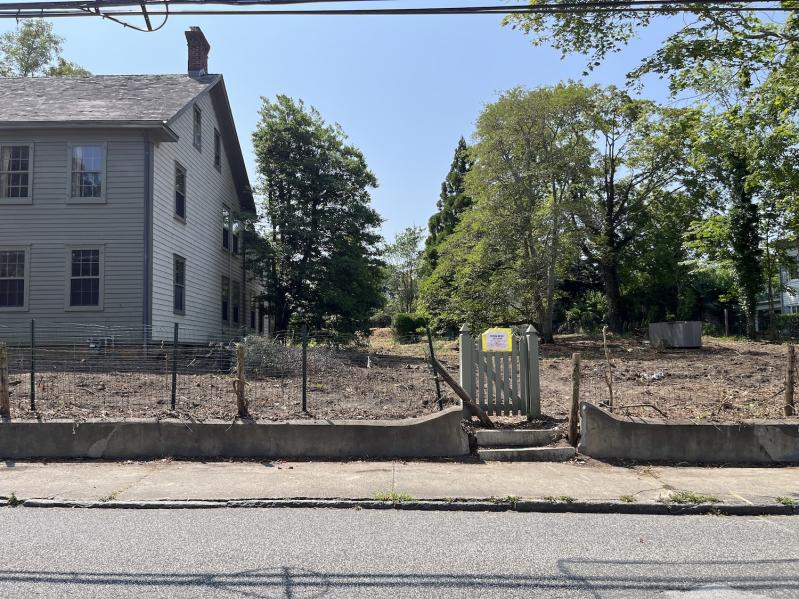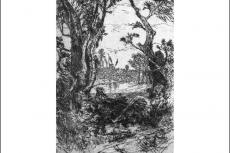There was an audible gasp from the audience Tuesday night when Eileen Rosenfeld, speaking at a Sag Harbor Village Board public hearing on a proposed tree-preservation law, held up a poster-size picture of a recently clear-cut property in the village.
“Deputy Mayor Haye recently requested photos of properties where many trees were removed,” she said. “These are photos of properties before and after tree removal and with subsequent replanting. They illustrate how often, when given the opportunity, all trees on properties are felled, and usually replaced with lawns and hedges, not new trees.”
Ms. Rosenberg spoke calmly, but her frustration was clear. She told the audience she has been working through four administrations to try to enact this code change.
Some aspects of the draft legislation were hardly debated: Dead, diseased, or severely damaged trees, after checked by a certified arborist, can be removed. After a weather emergency, a resident can remove a tree for safety reasons. And, the village’s department of public works will not be subject to the law.
The main problem people had with the proposed law was that it would allow the removal, without a permit, of any tree having less than an 18-inch “D.B.H.” (diameter at breast height).
Ms. Rosenberg and seven others said it should be much lower — 12 inches D.B.H. at most.
“If we leave it at 18 inches,” said Geraldine Maslanka, calling in via Zoom, “this legislation would be moot.”
“I disagree with that last comment completely,” said Ed Haye, the deputy mayor. “We have taken arborists’ advice for 18 inches for a variety of reasons.”
However, the 12-inch D.B.H people had their experts too. “We are supported in our position by several I.S.A. Arborists,” said Ms. Rosenberg.
Only one person, Anthony Vermandois, asked for fewer restrictions regarding clearing. He argued that a permit shouldn’t be required to remove trees in the way of septic systems, or trees close to existing structures.
He also addressed “the D.B.H. controversy,” and suggested a potential compromise. Nonnative trees, Mr. Vermandois said, should have a lower removal threshold, while native or “historically significant” trees should require more scrutiny and permitting.
His comment greatly influenced the advancing conversation. Aidan Corish, a village trustee, asked Silas Marder, a village resident whose family has owned the eponymous tree nursery and landscape design company for 50 years, if there was an accepted list of native and nonnative trees.
Mr. Marder said there was, but allowed that some species on the list were debatable. If the 18-inch D.B.H. was applied to his own yard, he said, many trees could be removed without a permit. He worried that people might be confused by such a high D.B.H., and that it could lead to increased clearing.
“I think a lot of this is a knee-jerk reaction to lots that have been overcleared by developers,” said Bob Plumb, a board member. The proposed law, he said, could clarify restrictions, as it states that building permit applications require the submission of tree-removal permits.
Diameter alone, Mr. Plumb added, should not be the only measure of a tree’s value. He agreed, he said, with the growing consensus that native trees deserved a greater level of protection.
“We don’t want to protect the invasive at all,” said Jeanne Kane, also a trustee.
But Mr. Haye, increasingly isolated, feared those distinctions could turn into complications, making the law more difficult to administer. He said the village was already overburdened with enforcement, and the law had to be kept as simple and easy as possible.
“I hear some resistance” to the 12-inch D.B.H, said Kate Plumb. “The only argument I heard to keep it at 18 is that it’s easier for the village. To me, taking down a 40 or 50-year-old tree because it’s easier is not a viable option.” It would take “moral courage,” she said, for the board to stand up for the older trees, and urged them to move the D.B.H. to 12 inches.
Mr. Haye said ease wasn’t the only reason, citing property rights. “People have the right to manage their own property.” But Ms. Rosenberg got up again to say, “It’s not just about the homeowner, it’s about the surrounding neighbors. There’s a certain environment that they came here for, and that’s becoming minimal.” Her comments were met with applause.
Thomas Gardella, the mayor, told a story that highlighted the impact of tree removal, regardless of the species. His neighbor had removed a stand of invasive trees, he said, and his daughter was brought to tears. “It’s an emotional issue, and something we should get right.”
Jayne Young, who was a co-signer of the prepared remarks given earlier by Ms. Rosenberg, offered another compromise: that the village do a trial period using the 12-inch D.B.H. as the law.
“I have serious questions about the 18-inch diameter,” said Mayor Gardella.
“I do, too,” said Mr. Corish.
When the mayor observed that “the overall majority say it should be 12 inches,” more applause rippled through the room.
“I like the idea of identifying two groups of trees, the invasive and noninvasive,” said Mr. Corish. “I don’t think we work for the ease of the building department.”
“You have to think about the administration of this,” said Mr. Haye.
“I understand that,” Mr. Corish replied, “but I don’t accept that we can’t administer this, because otherwise, we might as well just fold up our tent. We have the responsibility to legislate, and a responsibility to create the environment for that legislation to be enforced. We can’t turn down the idea based on the fact that ‘I don’t know how we’re going to enforce this.’ “
“The legislation needs to be more nuanced than it is currently. We have this very black-and-white argument about 18 inches versus 12 inches,” he continued. “I think we need to look at this with a little more detail. I don’t think this is ready for adoption, but I do feel we’ve made some progress tonight.”
The public hearing will continue at the village board’s Nov. 14 meeting.




